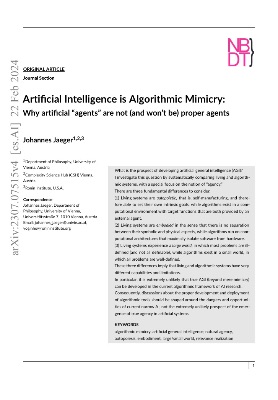Debunking the Hype: The Truth About AI Agents
 Gerard Sans
Gerard Sans
The rapid advancement of Large Language Models (LLMs) has sparked a narrative of "AI agents" capable of autonomous decision-making and action. This perception, while captivating, often misrepresents the current state of AI capabilities. In this article, we'll critically examine this narrative and propose a more accurate framework for understanding AI systems. By reframing the concept of AI agency as "AI workflows," we can foster a more nuanced and responsible approach to AI literacy.
Defining True Agency: A Framework for Evaluation
To assess claims of AI agency, we must first establish a clear definition. A true agent possesses the following fundamental properties:
Intentionality: Purposeful action driven by internal goals and an understanding of why actions are performed.
Self-Awareness: An internal model of self, capabilities, and relationship to the environment.
Adaptive Learning: The ability to learn from experience, adjust behavior based on feedback, and evolve beyond pre-programmed patterns.
Autonomous Action: Independent decision-making and action initiation without external control.
Limitations of Current AI Systems: A Critical Analysis
Despite their impressive performance in specific tasks, current AI models fall short of these criteria for true agency. Their operation is more accurately characterized as sophisticated pattern matching driven by statistical probabilities derived from training data. Key limitations include:
Absence of Intentionality: AI models lack internal goals and genuine understanding of purpose. Outputs are generated in response to external prompts, not driven by internal motivations.
Lack of Self-Awareness: AI systems possess no internal representation of themselves or their relationship to the environment, lacking the reflective capacity for self-adjustment.
Constrained Learning: While AI models adjust parameters based on training data, this is distinct from true adaptive learning. They struggle to generalize and exhibit limited adaptation in dynamic environments.
Dependence on External Control: AI models require external input (prompts) and operate within predefined parameters, lacking autonomy to initiate actions independently.
“AI is Algorithmic Mimicry: Why artificial “agents” are not (and won’t be) proper agents”, Johannes Jaeger. Source.
The Missing Feedback Loop: Inability to Recover from Failures
A significant limitation of current AI systems is their inability to learn from mistakes and self-correct in real-time. True agents possess feedback mechanisms for adaptation based on action outcomes. Current AI models lack this crucial capability:
Delayed Feedback and Updates: Model improvements require retraining or fine-tuning, which are time-consuming and computationally expensive, preventing real-time adaptation.
Lack of Real-Time Self-Correction: Current AI "agents" cannot autonomously recover from failures, repeating errors given the same input. Brute-force repetition does not constitute self-correction.
AI Workflows: A More Accurate Representation
Given these limitations, we propose "AI workflow" as a more accurate term to describe the current operational paradigm of AI technologies. This concept acknowledges the power of AI systems while recognizing their inherent constraints:
Structured Processes: AI workflows involve a series of predefined steps, often combining multiple AI models and external services.
Human Oversight: These workflows typically require human intervention for initiation, monitoring, and error correction.
Task-Specific Design: AI workflows are tailored to specific tasks or domains, lacking the generalizability of true agency.
Challenges in AI Workflows
While integrating AI models into workflows can be beneficial, it also amplifies existing limitations:
Narrow Generalization: AI models struggle to apply knowledge outside their training domain.
Out-of-Distribution Challenges: Performance degrades when faced with inputs significantly different from training data.
Hallucinations: AI models can generate plausible but incorrect information.
Partially Correct Outputs: Results may contain a mix of accurate and inaccurate information.
Uncertainty and Unreliability: AI models lack a robust understanding of their own limitations.
Additional challenges arise from workflow dependencies:
External Component Reliance: Integration with external services introduces potential points of failure.
Increased Resource Demands: Workflows involving multiple AI components can be computationally expensive and slow.
Verbose Execution: Reliance on multiple components and communication layers can lead to inefficiency.
Conclusion: Promoting Responsible AI Literacy
Accurate characterization of AI capabilities is crucial for responsible development and deployment. The term "AI agent" perpetuates a misleading narrative of autonomy and intentionality. In contrast, "AI workflow" offers a more precise representation, acknowledging current limitations while allowing for future advancements.
By adopting this terminology, we can:
Foster a nuanced understanding of AI systems among developers, policymakers, and the general public.
Encourage realistic expectations of AI capabilities and limitations.
Promote responsible AI development practices that prioritize transparency and human oversight.
Guide ethical considerations in AI integration across various sectors.
As we continue to push the boundaries of AI technology, maintaining clear and accurate terminology is paramount. This approach not only enhances AI literacy but also paves the way for responsible innovation and the potential development of true AI agency in the future.
Subscribe to my newsletter
Read articles from Gerard Sans directly inside your inbox. Subscribe to the newsletter, and don't miss out.
Written by

Gerard Sans
Gerard Sans
I help developers succeed in Artificial Intelligence and Web3; Former AWS Amplify Developer Advocate. I am very excited about the future of the Web and JavaScript. Always happy Computer Science Engineer and humble Google Developer Expert. I love sharing my knowledge by speaking, training and writing about cool technologies. I love running communities and meetups such as Web3 London, GraphQL London, GraphQL San Francisco, mentoring students and giving back to the community.
